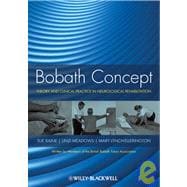
What is included with this book?
Linzi Meadows is Clinical Director of the Manchester Neurotherapy Centre and Neurological Teaching Centre, as well as an Advanced Bobath Tutor.
Mary Lynch-Ellerington F.C.S.P is Fellow of the Chartered Society of Physiotherapy and a Senior Bobath Instructor.
| Foreword | p. viii |
| Preface | p. xii |
| Contributors | p. xiv |
| Acknowledgements | p. xv |
| The Bobath Concept: Developments and Current Theoretical Underpinning | p. 1 |
| Introduction | p. 1 |
| The founders and development of the Bobath Concept | p. 1 |
| Current theory underpinning the Bobath Concept | p. 3 |
| Systems approach to motor control | p. 4 |
| Clinical application of the theory underpinning the Bobath Concept | p. 11 |
| Summary | p. 16 |
| References | p. 17 |
| An Understanding of Functional Movement as a Basis for Clinical Reasoning | p. 23 |
| Introduction | p. 23 |
| Normal movement versus efficient movement | p. 24 |
| Compensatory strategies | p. 25 |
| Motor control and motor learning | p. 26 |
| Requirements of efficient movement | p. 31 |
| Summary | p. 37 |
| References | p. 39 |
| Assessment and Clinical Reasoning in the Bobath Concept | p. 43 |
| Introduction | p. 43 |
| Models of clinical reasoning and the Bobath Concept | p. 45 |
| Key characteristics of assessment using the Bobath Concept | p. 47 |
| Basis for clinical reasoning | p. 52 |
| Illustrating clinical reasoning using the Bobath Concept | p. 53 |
| Summary | p. 57 |
| References | p. 61 |
| Practice Evaluation | p. 64 |
| Introduction | p. 64 |
| Evaluation in the context of the International Classification of Function, Disability and Health | p. 65 |
| Factors influencing measurement selection | p. 66 |
| Measurement properties | p. 68 |
| Measures | p. 70 |
| Summary | p. 78 |
| References | p. 79 |
| Moving Between Sitting and Standing | p. 83 |
| Introduction | p. 83 |
| Clinical considerations from the literature | p. 84 |
| Phases of sit to stand | p. 86 |
| Movements from standing to sitting | p. 89 |
| Effects of ageing | p. 92 |
| Sit to walk | p. 93 |
| Clinical aspects | p. 93 |
| Movement in functional contexts | p. 95 |
| Clinical examples | p. 98 |
| References | p. 114 |
| The Control of Locomotion | p. 117 |
| Introduction | p. 117 |
| Key aspects of bipedalism | p. 117 |
| The gait cycle | p. 122 |
| Use of body weight support treadmill training in the Bobath Concept | p. 127 |
| Assistive devices | p. 129 |
| Outcome measures | p. 147 |
| Summary | p. 149 |
| References | p. 149 |
| Recovery of Upper Limb Function | p. 154 |
| Introduction | p. 154 |
| The importance of postural control in upper limb function | p. 155 |
| The shoulder complex | p. 157 |
| Functional reach | p. 162 |
| The hand | p. 170 |
| Early treatment and management of the hand | p. 170 |
| Assessment of the hand | p. 171 |
| Contactual hand-orientating response | p. 173 |
| Selective strength training of the intrinsic muscles of the hand | p. 173 |
| Summary | p. 177 |
| References | p. 178 |
| Exploring Partnerships in the Rehabilitation Setting: The 24-Hour Approach of the Bobath Concept | p. 182 |
| Partnerships in the rehabilitation environment | p. 182 |
| The early days | p. 184 |
| Overcoming sensory deprivation and stimulating body schema | p. 190 |
| Scheduling the day-opportunities for practice | p. 191 |
| Return to work | p. 194 |
| Summary | p. 202 |
| References | p. 204 |
| Index | p. 208 |
| Table of Contents provided by Ingram. All Rights Reserved. |
The New copy of this book will include any supplemental materials advertised. Please check the title of the book to determine if it should include any access cards, study guides, lab manuals, CDs, etc.
The Used, Rental and eBook copies of this book are not guaranteed to include any supplemental materials. Typically, only the book itself is included. This is true even if the title states it includes any access cards, study guides, lab manuals, CDs, etc.